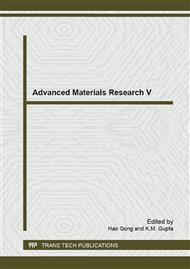p.123
p.127
p.131
p.136
p.141
p.149
p.154
p.159
p.164
Synthesis of Anatase and Rutile TiO2 Crystals for High-Performance Dye-Sensitized Solar Cells
Abstract:
TiO2 nanosize particles have attracted significant interest of materials scientists and physicists due to their special properties and have attained a great importance in several technological applications such as photocatalysis, sensors, solar cells and memory devices. TiO2 nanoparticles can be produced by a variety of techniques ranging from simple chemical to mechanical to vacuum methods, including many variants of physical and chemical vapour deposition techniques. In the present research work we report the synthesis of TiO2 nanoparticles by Sol-Gel technique. The characterization of particles was carried out by XRD and SEM techniques. The importance and applications of these nanoparticles for solar cells are also discussed in this work. Recently, the importance of tailored particles has been recognized in a number of applications such as solar cells and photonic crystals. Among the many metal oxides and their inorganic-organic hybrid materials used for the above applications, one of the most important and complex in this regard is titanium dioxide (titania). In this study, the processing parameters in an alkoxide free sol-gel synthesis of anatase titania nanoparticles were investigated. Factors affecting the sol-gel process include the reactivity of inorganic titanium salt, calcinations temperature, the influence of varying stirrer speeds on the formation of anatase particles, and the nature of hydrolytic solvent and peptisation reagent. By varying these processing parameters, materials with different microstructure and surface chemistry can be obtained.
Info:
Periodical:
Pages:
141-145
Citation:
Online since:
May 2015
Keywords:
Price:
Сopyright:
© 2015 Trans Tech Publications Ltd. All Rights Reserved
Share:
Citation:


